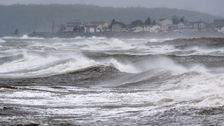TORONTO (AP) — Fiona washed houses into the sea, tore the roofs off others and knocked out power to the vast majority of two Canadian provinces Saturday as it made landfall as a big, powerful post-tropical cyclone.
Fiona transformed from a hurricane into a post-tropical storm late Friday, but it still had hurricane-strength winds and brought drenching rains and huge waves. There was no confirmation of fatalities or injures.
Advertisement
Ocean waves pounded the town of Channel-Port Aux Basques on the southern coast of Newfoundland, where entire structures were washed into the sea. Mayor Brian Button said Saturday over social media that people were being evacuated to high ground as winds knocked down power lines.
“We’ve already had houses … that are washed away,” he said.
Button said anybody who has been told to leave their home needs to leave.
“I’m seeing homes in the ocean. I’m seeing rubble floating all over the place. It’s complete and utter destruction. There’s an apartment that is gone, that is literally just rubble,” said René J. Roy, a resident of Channel-Port Aux Basques and chief editor at Wreckhouse Press, said in a phone interview.
Andrew Vaughan / The Canadian Press via Associated Press
Roy estimated between eight to 12 houses and buildings have washed into the sea. “It’s quite terrifying,” he said.
Advertisement
Jolene Garland, a spokeswoman for the Royal Canadian Mounted Police in Newfoundland and Labrador, said a woman was safe after being “tossed into the water as her home collapsed” in the Channel-Port Aux Basques area. She said authorities received a report of another who woman was apparently swept out from the basement, but storm conditions are too dangerous to conduct a search.
The Royal Canadian Police said the town of 4,000 is in a state of emergency as authorities deal with multiple electrical fires and residential flooding.
Federal Minister of Emergency Preparedness Bill Blair told The Associated Press he expects the Canadian Armed Forces to help in the recovery including possibly moving people around, assisting with shelters and providing help with the removal of debris in addition to rescue operations should it be needed.
“They are moving now,” Blair said. “The damage is very extensive. We’ve seen homes, community centers, apartment buildings, roadways, bridges have all been impacted.”
Darren Calabrese / The Canadian Press via Associated Press
Advertisement
Blair also said there is very extensive damage at the airport in Sydney, Nova Scotia and at other airports including Halifax but it is more minor damage at Nova’s Scotia’s largest airport.
Halifax Mayor Mike Savage said the roof of an apartment building collapsed and they moved 100 people to a evacuation center. He said no one was seriously hurt or killed. Provincial officials said there are other apartment buildings that are also significantly damaged. Halifax has about 160 people displaced from two apartments, officials said.
More than 415,000 Nova Scotia Power customers — about 80%o f the province of almost 1 million — were affected by outages Saturday morning. Over 82,000 customers in the province of Prince Edward Island, about 95%, were also without power, while NB Power in New Brunswick reported 44,329 were without electricity.
The fast-moving Fiona made Nova Scotia landfall before dawn Saturday, with its power down from the Category 4 strength it had early Friday when passing by Bermuda, though officials there reported no serious damage.
The Canadian Hurricane Centre tweeted early Saturday that Fiona has the lowest pressure ever recorded for a storm making landfall in Canada. Forecasters had warned it could be the one of the most powerful storms to hit the country.
Advertisement
A state of local emergency has also been declared by the mayor and council of the Cape Breton Regional Municipality..
“There are homes that have been significantly damaged due to downed trees, big old trees falling down and causing significant damage. We’re also seeing houses that their roofs have completely torn off, windows breaking in. There is a huge amount of debris in the roadways,” Amanda McDougall, mayor of Cape Breton Regional Municipality, told The Associated Press
“There is a lot of damage to belongings and structures but no injuries to people as of this point. Again we’re still in the midst of this,” she said. “It’s still terrifying. I’m just sitting here in my living room and it feels like the patio doors are going to break in with those big gusts.”
A hurricane watch was issued for coastal expanses of Nova Scotia, Prince Edward Island and Newfoundland.
Advertisement
Nova Scotia Premier Tim Houston said they have requested military and disaster assistance from the federal government. He said roads are washed out including his own and said an “incredible” amount of trees down
“It is pretty devastating. The sad reality is the people who need information are unable to hear it. Their phones are not working, they don’t have power or access to the internet,” Houston said.
Peter Gregg, President and CEO of Nova Scotia Power, said unprecedented peak winds caused severe damage. “In many areas, weather conditions are still too dangerous for our crews to get up in our bucket trucks,” Gregg said. He said about 380,000 customers remain without power as of Saturday afternoon.
Prince Edward Island Premier Dennis King said they’ve also had no reports of any significant injures or worse. “Islanders heeded the warnings,” he said. King said few communities were spared and said the devastation looks to be beyond anything they’ve witnessed in the province. He said over 95% of islanders remain without power.
The U.S. hurricane center said Fiona had maximum sustained winds of 75 mph (120 kph) Saturday. It was moving across the Gulf of St. Lawrence slowly.
Advertisement
Hurricane-force winds extended outward up to 115 miles (185 kilometers) from the center and tropical storm-force winds extended outward up to 405 miles (650 kilometers).
Hurricanes in Canada are somewhat rare, in part because once the storms reach colder waters, they lose their main source of energy. But post-tropical cyclones still can have hurricane-strength winds, although they have a cold core and no visible eye. They also often lose their symmetric form and more resemble a comma.
In Sydney, Nova Scotia, the largest city in Cape Breton, about 20 people have taken refuge at the Centre 200 sports and entertainment facility, said Christina Lamey, a spokeswoman for the region. Lemay said there are hundreds of people displaced in the province.
Arlene and Robert Grafilo fled to Centre 200 with their children, aged three and 10, after a massive tree fell on their duplex apartment.
via Associated Press
Advertisement
“We were trapped and we couldn’t open the doors and the windows, so that’s when we decided to call 911,” said Arlene Grafilo, adding firefighters eventually rescued them.
Bob Robichaud, Warning Preparedness Meteorologist for the Canadian Hurricane Centre, said Fiona was shaping up to be a bigger storm system than Hurricane Juan, which caused extensive damage to the Halifax area in 2003.
Fiona so far has been blamed for at least five deaths — two in Puerto Rico, two in the Dominican Republic and one in the French island of Guadeloupe.
Meanwhile, the National Hurricane Center said newly formed Tropical Storm Ian in the Caribbean was expected to keep strengthening and hit Cuba early Tuesday as a hurricane and then hit southern Florida early Wednesday.
It was centered about 270 miles (435 kilometers) southeast of Kingston, Jamaica. It had maximum sustained winds of 45 mph (75 kph) and was moving west-northwest at 16 mph (26 kph). A hurricane watch was issued for the Cayman Islands.
Advertisement
Morgan Lee in Ventura, California, contributed to this report.
Related posts:
Views: 0
 RSS Feed
RSS Feed

















 September 25th, 2022
September 25th, 2022  Awake Goy
Awake Goy 






 Posted in
Posted in  Tags:
Tags: 























